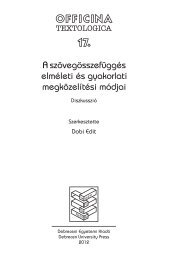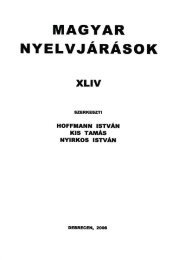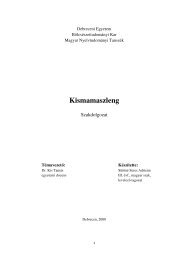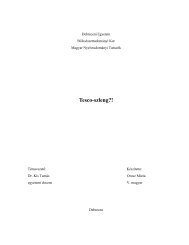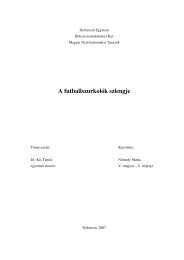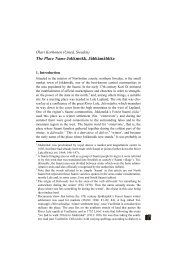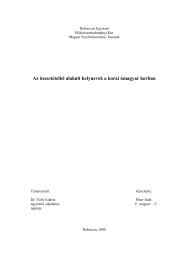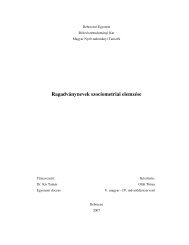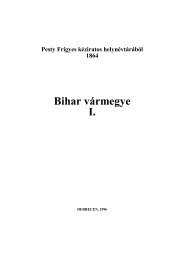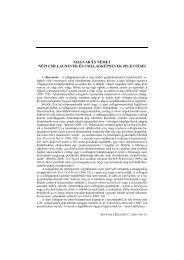A Historical Survey of the Study of Komi Toponyms
A Historical Survey of the Study of Komi Toponyms
A Historical Survey of the Study of Komi Toponyms
You also want an ePaper? Increase the reach of your titles
YUMPU automatically turns print PDFs into web optimized ePapers that Google loves.
A. G. Musanov (Syktyvkar, Russia)A <strong>Historical</strong> <strong>Survey</strong> <strong>of</strong> <strong>the</strong> <strong>Study</strong> <strong>of</strong> <strong>Komi</strong> <strong>Toponyms</strong>The rich and highly varied system <strong>of</strong> place names in <strong>the</strong> <strong>Komi</strong> areaattracted researchers’ attention as early as in <strong>the</strong> 15 th –16 th centuries,but it was only <strong>the</strong> early 20 th century that saw <strong>the</strong> appearance<strong>of</strong> linguistic studies in <strong>the</strong> real sense <strong>of</strong> <strong>the</strong> word.S. HERBERSTEIN’s (1486–1566) 1 “Записки о Московитских делах” (editionsin English: Notes upon Russia: being a translation <strong>of</strong> <strong>the</strong> earliest account<strong>of</strong> that country, entitled Rerum Moscoviticarum commentarii by <strong>the</strong>Baron Sigismund von Herberstein; translated and edited, with notes and anintroduction, by R. H. Major. London: Printed for <strong>the</strong> Hakluyt Society,1851–1852; Description <strong>of</strong> Moscow and Muscovy, 1557, by Sigmund vonHerberstein; edited by Bertold Picard; translated [from <strong>the</strong> German] by J. B.C. Grundy. London: Dent, 1969) can be considered to be one <strong>of</strong> <strong>the</strong> mostimportant sources on <strong>the</strong> beginnings <strong>of</strong> <strong>Komi</strong> toponymic studies. As envoy<strong>of</strong> <strong>the</strong> Austrian court, <strong>the</strong> author visited Russia twice, in 1516–1518 and1526–1527. In compiling his notes he drew upon <strong>the</strong> oral and writtensources <strong>of</strong> his time. Apart from information on neighbouring countries, peoplesand lands, <strong>the</strong>y contain a geographical survey <strong>of</strong> Muscovy (or MoscowRus) in <strong>the</strong> 16 th century. As far as <strong>Komi</strong> toponyms are concerned, it is <strong>the</strong>names <strong>of</strong> rivers and hills in <strong>the</strong> nor<strong>the</strong>rn area that are <strong>of</strong> special interest. S.Herberstein makes use <strong>of</strong> a Russian travel book entitled “Дорожник” (Book<strong>of</strong> Roads), which has not come down to us, in describing <strong>the</strong> journey toPechora, Jugra and Ob. Besides Pechora, <strong>the</strong> following hydronyms arementioned: Подчерем, Уса, Щугур, Чирка, Цильма as well as rivers, nowflowing in <strong>the</strong> Udorsk district <strong>of</strong> <strong>the</strong> <strong>Komi</strong> Republic: Вычегда and Мезень.The author lists several names current in <strong>the</strong> Ural mountains: Земной пояс‘earthly belt, belt <strong>of</strong> <strong>the</strong> earth’, Каменный пояс ‘stone belt’, Пояс ‘belt’, Камень‘stone’, Большой Камень ‘big stone’, Камень Большого Пояса ‘stone<strong>of</strong> <strong>the</strong> big belt’, Пояс мира и земли ‘stone <strong>of</strong> <strong>the</strong> world and <strong>the</strong> earth’,Столп ‘column, post’. HERBERSTEIN’s work is interesting as a historicalguide in <strong>the</strong> first place.The most ancient monument <strong>of</strong> historical geography <strong>of</strong> <strong>the</strong> 17 th century is“Книга Большому Чертежу”, 2 which is a ra<strong>the</strong>r detailed explanatory textsupplied to two sketches <strong>of</strong> <strong>the</strong> Russian state: to <strong>the</strong> old one, whose date <strong>of</strong>emergence is unknown, and to <strong>the</strong> new one, which was made in 1627. In it1 ГЕРБЕРШТЕЙН, С. Записки о Московитских делах. Санкт-Петербург 1908.2 Книга Большому Чертежу. Москва–Ленинград 1950.
162A. G. Musanov<strong>the</strong> geographic description is based mainly on rivers as <strong>the</strong> most importanttransport routes <strong>of</strong> <strong>the</strong> time. <strong>Komi</strong> place names figuring in <strong>the</strong> Book is partlydescribed by <strong>the</strong> German scholar V. STEINITZ (1962, 1963). In <strong>the</strong> Book<strong>the</strong>re is a small group <strong>of</strong> <strong>Komi</strong> toponyms listed with <strong>the</strong>ir translations intoRussian: “Воикар или Ноцнои” (cf. <strong>Komi</strong> вой ‘nightly, nocturnal’, кар‘town’, ‘fortress’), “Уркар или Белои” (cf. <strong>Komi</strong> ур ‘squirrel’) and o<strong>the</strong>rs.In 1724, Peter I decreed to establish <strong>the</strong> Academy <strong>of</strong> Sciences. The researchwork within its framework soon embraced ma<strong>the</strong>matics and sciences as wellas <strong>the</strong> examination <strong>of</strong> natural resources and <strong>the</strong> ethnic distribution <strong>of</strong> Russia’spopulation.At <strong>the</strong> end <strong>of</strong> <strong>the</strong> 17 th century, member <strong>of</strong> <strong>the</strong> Academy, I. I. LEPEKHIN(1740–1802) made a journey to <strong>Komi</strong>land as participant <strong>of</strong> <strong>the</strong> Orenburg expedition.This famous geographical expedition between 1768 and 1772 set<strong>the</strong> goal to study <strong>the</strong> Volga area, <strong>the</strong> Ural, part <strong>of</strong> Siberia, <strong>the</strong> Arkhangelskregion and <strong>the</strong> coastline <strong>of</strong> <strong>the</strong> White Sea. The most complete informationon <strong>the</strong> route <strong>of</strong> <strong>the</strong> Orenburg expedition is given in “Дневныe запискипутешествия доктора и Академии наук адъютанта Ивана Лепехина поразным провинциям Российского государства” (Daily notes on <strong>the</strong> journeymade by Ivan Lepekhin, doctor and aid <strong>of</strong> <strong>the</strong> Academy <strong>of</strong> Sciences,into different provinces <strong>of</strong> <strong>the</strong> Russian state). The publication was begun in1771 and finished in 1814, well after I. I. LEPEKHIN’s death.I. I. LEPEKHIN started exploring <strong>the</strong> <strong>Komi</strong> area from <strong>the</strong> south along <strong>the</strong> riversLuzi, Sysola, and Vymi up to <strong>the</strong> estuary <strong>of</strong> Vychegda. According to <strong>the</strong>author, <strong>the</strong> <strong>Komi</strong> inhabited <strong>the</strong> territory from <strong>the</strong> settlement Ust-Pyras (todayKotlas), situated near <strong>the</strong> estuary <strong>of</strong> Vychegda. In <strong>the</strong> 3 rd volume <strong>of</strong> “Дневныeзаписки” <strong>the</strong>re is a description <strong>of</strong> several rivers and populated areas, aswell as valuable information on <strong>the</strong> <strong>Komi</strong>s’ language and <strong>the</strong>ir way <strong>of</strong> life.The 4 th volume, <strong>the</strong> greater part <strong>of</strong> which was written and edited by N. Y.OZERETSKOVSKIJ, I. I. LEPEKHIN’s aid in <strong>the</strong> expedition, has short chaptersentitled “О Устьцыльме” (On Usttsylm), “О Ижме” (On Izhma), “Сведенияо зырянах” (On <strong>the</strong> Zyryan) and contains a variety <strong>of</strong> toponyms.In 1837 <strong>the</strong> Botanic Gardens in St Petersburg entrusted A. I. SCHRENK(1816–1876) 3 to lead an expedition to <strong>the</strong> undisclosed areas <strong>of</strong> <strong>the</strong> northwest<strong>of</strong> European Russia. The description <strong>of</strong> <strong>the</strong> journey was written inGerman and published in two volumes. The Russian translation <strong>of</strong> <strong>the</strong> firstvolume came out in 1855. The author lists places names current in <strong>the</strong> tundras<strong>of</strong> Малaя земля (small land) and Большaя земля (large land) and in3 ШРЕНК, А. Путешествие к северо-востоку Европейской России через тундру самоедовк северным Уральским горам, предпринятое по высочайшему повелению в 1837году. Санкт-Петербург 1855.
164A. G. Musanov<strong>of</strong> <strong>the</strong> Academy’s assistant researchers from <strong>the</strong> departure to <strong>the</strong> submission<strong>of</strong> <strong>the</strong> final report” (BOGORAZ 1927, p. 5).M. A. CASTRÉN investigated almost all <strong>the</strong> nor<strong>the</strong>rn territories and <strong>the</strong>whole <strong>of</strong> Siberia, collecting an enormous amount <strong>of</strong> material. His illness andearly death, however, prevented him from sorting it out properly. All his diaries,notes and letters written during <strong>the</strong> journey contain geographicalnames, carefully collected by him throughout his career as a scholar. If <strong>the</strong>rewas a possibility, he also recorded toponymic legends. Using toponymicevidence in identifying <strong>the</strong> ancient inhabitants <strong>of</strong> <strong>the</strong> North with <strong>the</strong> Biarmsand <strong>the</strong> Biarms with <strong>the</strong> Karelians he proved that Baltic Finnic tribes used tolive not only about <strong>the</strong> nor<strong>the</strong>rn reaches <strong>of</strong> <strong>the</strong> river Dvina but also along <strong>the</strong>river Mezen.After M. A. CASTRÉN’s death his material was edited and published by academicianA. A. SCHIFNER in 12 volumes. Their significance is invaluable inthat it has <strong>the</strong> richest store <strong>of</strong> toponyms that are also important from a historicalperspective (AGEEVA 1970, MATVEEV 1971, pp. 9–10).From about <strong>the</strong> middle <strong>of</strong> <strong>the</strong> 19 th century special scholarly societies and institutionswere formed for geographical and ethnographic research. The first<strong>of</strong> this kind in Russia was <strong>the</strong> Russian Geographical Society with a branch<strong>of</strong> ethnography, which conducted extensive expeditions, brought out publicationsand popularized its findings from <strong>the</strong> very beginning <strong>of</strong> its existence.The first instance <strong>of</strong> <strong>the</strong> individual activity <strong>of</strong> <strong>the</strong> society was <strong>the</strong> organization<strong>of</strong> an expedition to <strong>the</strong> Ural Mountains with <strong>the</strong> aim <strong>of</strong> drawing <strong>the</strong> borderlinebetween Europe and Asia along <strong>the</strong> whole chain <strong>of</strong> <strong>the</strong> Ural. The expeditionwas headed by Pr<strong>of</strong>essor E. K. HOFFMAN (1801–1871), 6 an expertin mineralogy and geology at St Petersburg University. His book was publishedin Russian and German simultaneously and can be regarded as <strong>the</strong>first systematic description <strong>of</strong> <strong>the</strong> Pay-Hoy area and <strong>the</strong> Ural beyond <strong>the</strong> PolarCircle.In E. K. HOFFMAN’s work toponyms are more varied than in that <strong>of</strong> A. I.SCHRENK with regard to both <strong>the</strong> area covered and <strong>the</strong> bulk <strong>of</strong> linguistic materialdiscussed. E. K. HOFFMAN collected material for a toponymic dictionary<strong>of</strong> <strong>the</strong> Nor<strong>the</strong>rn Ural (names <strong>of</strong> hills and rivers) as well as made a list <strong>of</strong>non-Russian geographical names. Part <strong>of</strong> <strong>the</strong>se is contrastively presented,with one and <strong>the</strong> same place named in different languages, such as <strong>Komi</strong>Сабля-Из, Nenets Саукка-Ур; <strong>Komi</strong> Барабан-Из, Mansy Коип; <strong>Komi</strong>Адзва, Nenets Хирмор-Яга, etc.6 ГОФМАН, Э. K. Северный Урал и береговой хребет Пай-Хой. Исследования экспедиции,снаряженной Императорским русским географическим обществом в 1847, 1848и 1850 годах. 2. Санкт-Петербург 1856.
166A. G. Musanov(Geographico-statistical Dictionary <strong>of</strong> <strong>the</strong> Russian Empire), edited by P. P.SEMENOV. 9 The dictionary contains <strong>the</strong> characteristics <strong>of</strong> all mountain systems(some <strong>of</strong> <strong>the</strong> knolls/hillocks and peaks <strong>of</strong> <strong>the</strong> Urals are also given), informationon <strong>the</strong> provinces and towns, lakes, moors, islands, capes and rapids.It has about 16,000 descriptions <strong>of</strong> locations and short monographsbased on original sources. Over a hundred entries are devoted to <strong>Komi</strong>names. It is especially noteworthy that several <strong>of</strong> <strong>the</strong>m are given in differentlanguages, e.g., <strong>the</strong> river Колва, Тодш-яга or Точьяга in Nenets; Сереговское,Серег-Ыб in <strong>Komi</strong>; Тельпос-Из, Khanty Не-Пуби-Ур; Тима-Из,Russian Тимофеев камень, etc. P. P. SEMENOV’s Dictionary is frequentlyused by researchers even today, although not each piece <strong>of</strong> information andnot each attempt at <strong>the</strong> interpretation <strong>of</strong> geographical names is fully trustworthy.It can be, however, unanimously stated that <strong>the</strong> Dictionary is <strong>the</strong>most complete work with its voluminous material on <strong>the</strong> geography <strong>of</strong> contemporaryRussia.In 1878 <strong>the</strong> Archeological, <strong>Historical</strong> and Ethnographic Society was foundedat <strong>the</strong> University <strong>of</strong> Kazan’. It set <strong>the</strong> goal to study <strong>the</strong> Volga–Kamaarea. A circle <strong>of</strong> onomastics was also formed within <strong>the</strong> framework <strong>of</strong> <strong>the</strong>Society, in which M. P. WESKE, I. N. SMIRNOV, N. I. ANDERSON and o<strong>the</strong>rsplayed an active role. The members <strong>of</strong> <strong>the</strong> Society published <strong>the</strong>ir studies in<strong>the</strong> “Известия Общества археологии, истории и этнографии” (Journal <strong>of</strong><strong>the</strong> Archeological, <strong>Historical</strong> and Ethnographic Society).As regards <strong>Komi</strong> toponyms, it is <strong>the</strong> works <strong>of</strong> I. N. SMIRNOV (1856–1904), 10an ethnographist <strong>of</strong> fame and pr<strong>of</strong>essor <strong>of</strong> general history, that are <strong>of</strong> specialinterest. His book “Пермяки” (Permians) has a noteworthy inventory <strong>of</strong><strong>Komi</strong> toponyms, although it is <strong>Komi</strong> Permians that are <strong>the</strong> chief target <strong>of</strong> hisinvestigation, which is based on rich archival material and direct observationsmade during his expeditions. All this is a valuable source <strong>of</strong> research<strong>of</strong> <strong>Komi</strong> toponyms and anthroponyms, with over 300 geographical and personalnames taken from old documents and collected from <strong>the</strong> local population.What deserves attention is his conclusions about <strong>the</strong> one-time presence<strong>of</strong> Karels near <strong>the</strong> river Pinega as well as <strong>the</strong> Ugric tribes having once inhabited<strong>the</strong> Vychegda and Pechora regions and <strong>the</strong> Saami and <strong>the</strong> <strong>Komi</strong> havinglived in adjacent areas in <strong>the</strong> Vychegda and Suhona basins at one point <strong>of</strong><strong>the</strong>ir history.At <strong>the</strong> end <strong>of</strong> <strong>the</strong> 19 th century M. P. WESKE (1843–1890), a widely knownexpert in Finno-Ugric studies, published a book entitled “Славяно-финскиекультурные отношения” (Slavic-Finno-Ugric cultural relations), in which9 СЕМЕНОВ, П. П. Географическо-статистический словарь Российской империи. 1–5.Санкт-Петербург 1863–1885.10 СМИРНОВ, И. Н. Пермяки. Историко-этнографический очерк. Казань 1891.
168A. G. MusanovSeveral dictionaries published in <strong>the</strong> 19 th century contain plenty <strong>of</strong> reliableinformation on <strong>the</strong> natural objects in <strong>the</strong> <strong>Komi</strong> region. Among <strong>the</strong>se, <strong>the</strong> dictionarycompiled by P. MAKSIMOVICH and A. SHCHEKATOV 12 deserves specialattention as one having a huge list <strong>of</strong> provincial and regional towns, settlements,monasteries and <strong>the</strong> “most famous rivers”. Particularly interestingare <strong>the</strong> details given about <strong>the</strong> rivers Vychegda, Pechora and <strong>the</strong> town Ust’-Sysol’sk.At <strong>the</strong> beginning <strong>of</strong> <strong>the</strong> 20 th century toponymic research acquires a linguisticcharacter. One <strong>of</strong> <strong>the</strong> first scholars to be mentioned is I. Y. KRIVOSHCHE-KOV, geographist cartographist historian, archeologist, ethnographist andeconomist. He made <strong>the</strong> first geographical maps <strong>of</strong> <strong>the</strong> Solikamsk, Yekaterinburg,Verkhoturya and Cherdyn’ districts <strong>of</strong> <strong>the</strong> Perm province. The map<strong>of</strong> <strong>the</strong> Solikamsk district has an index attached, which was <strong>the</strong> first in a series<strong>of</strong> articles on <strong>the</strong> various districts. The next two dictionaries by I. Y.KRIVOSHCHEKOV were published in 1910 and 1914, continuing previousstudies <strong>of</strong> <strong>the</strong> Perm’ region. All <strong>the</strong> geographical dictionaries by I. Y.KRIVOSHCHEKOV comprise a rich store <strong>of</strong> <strong>Komi</strong>-Permian toponyms. Hissuccessor in <strong>the</strong> field was A. F. TEPLOUKHOV, 13 who continued to study<strong>Komi</strong>-Permian and substratum toponyms also in <strong>the</strong> Kama region. Hepointed out that <strong>the</strong>re used to be an Ugric population inhabiting <strong>the</strong> Kamaregion and <strong>the</strong> neighbouring <strong>Komi</strong> territories before <strong>the</strong> <strong>Komi</strong> occupied it.He quotes a number <strong>of</strong> interesting hydronymic parallels discovered in <strong>the</strong>habitat <strong>of</strong> present-day Ob Ugric peoples: <strong>the</strong> lakes Синдор and Синтур; <strong>the</strong>rivers Кулом and Кулом-еган, Вымь and Вым around <strong>the</strong> mouth <strong>of</strong> <strong>the</strong> riverIrtysh; Визинга (<strong>Komi</strong> Визин), Визин-еган and Визим (a tributary <strong>of</strong> <strong>the</strong>river North Sos’va).Concerning foreign authors, <strong>the</strong> prominent German Slavist M. VASMER(1886–1962) 14 published studies that are <strong>of</strong> particular significance for toponymicresearch. He has a series <strong>of</strong> articles on pre-Russian toponyms, inwhich he makes an attempt to fix <strong>the</strong> one-time distribution <strong>of</strong> Permian peo-12 МАКСИМОВИЧ, П.—ЩЕКАТОВ, А. Географический словарь Российского государства,сочиненный в настоящем оного виде. 1–7. Москва 1801–1808.13 ТЕПЛОУХОВ, А. Ф. Следы былого пребывания угорского народа в смежных частяхПермской и Вятской губернии и последующая смена его пермским и русским народами.In: Записки Уральского общества любителей языкознания 39 (Свердловск 1924),pp. 81–112; Фамилии и географические названия Пермяцкого края в этимологическоми историко-географическом отношениях. In: Коми му 9 (Усть-Сысольск 1925), pp.32–45; 10–11, pp. 83–95; 12, pp. 15–24; О происшедшей некогда смене угров пермякамина верхней Каме, коми на верхней Вычегде и удмуртами на Чепце. In: Ученыезаписки Пермского университета 12/1 (Пермь 1960), pp. 270–274.14 VASMER, M. Beiträge zur historischen Völkerkunde Osteuropas IV. Die ehemalige Ausbreitungder Lappen und Permier in Nordrussland. In: Sitzungsberichte der PreussischenAkademie der Wissenschaften. Philosophisch-historische Klasse. XVI–XX (Berlin 1936),pp. 176–270.
A <strong>Historical</strong> <strong>Survey</strong> <strong>of</strong> <strong>the</strong> <strong>Study</strong> <strong>of</strong> <strong>Komi</strong> <strong>Toponyms</strong>169ples in <strong>the</strong> North on <strong>the</strong>ir basis. He divides all <strong>the</strong> Permian names into certainstructural and semantic types according to <strong>the</strong> following formants: -шор(-шур) ‘brook’, -ва ‘water, river’, -вай ‘branch’, etc. There are also a considerablenumber <strong>of</strong> etymologies supported by present-day <strong>Komi</strong> and Udmurt.By <strong>the</strong> second half <strong>of</strong> <strong>the</strong> 20 th century toponymy had already had a greatnumber <strong>of</strong> special works in which questions raised by <strong>Komi</strong> toponyms weretouched upon in one way or ano<strong>the</strong>r. This period presents such outstandingfigures as V. I. LYTKIN, A. K. MATVEEV and B. A. SEREBRENNIKOV.In his special studies devoted to toponymy, V. I. LYTKIN makes an analysis<strong>of</strong> names that sound different but refer to one and <strong>the</strong> same geographical objectin adjacent, but genetically unrelated languages. The present-day differencesin <strong>the</strong>ir pronunciation can be explained by <strong>the</strong>ir being submitted to acertain phonetic rule in one language whereas <strong>the</strong>y are preserved in <strong>the</strong>ir ancientform in <strong>the</strong> o<strong>the</strong>r. Such toponyms represent an important source <strong>of</strong> historicalphonetics (LYTKIN 1966, 1970).In his works on toponymy A. I. POPOV 15 (1899–1973) makes use <strong>of</strong> <strong>the</strong>valuable material to be found in Russian chronicles and charters, scribalbooks and ancient acts. He holds <strong>the</strong> view that toponyms in <strong>the</strong> North can bedescended from different Finno-Ugric and Samoyed languages. Those thatcannot be interpreted on this basis could have belonged to <strong>the</strong> extinct language<strong>of</strong> <strong>the</strong> Zavolotsk Chud’. A. I. POPOV makes plenty <strong>of</strong> interesting observationson <strong>the</strong> formants -ега, -ига, -ога, -уга, -юга, -га, -нга, -ма, -ша,-са, -кша, -кса, which, in his opinion, do not all have <strong>the</strong> meaning ‘water,river’. Many <strong>of</strong> <strong>the</strong>m may contain word-formational elements.A. K. MATVEEV, a prominent toponym expert and Pr<strong>of</strong>essor <strong>of</strong> Ural Universityhas collected and generalized a tremendous amount <strong>of</strong> substratum toponyms<strong>of</strong> <strong>the</strong> North in his numerous works. He has worked out his ownmethodology <strong>of</strong> applying questionnaires in research. This methodology hasno analogy in <strong>the</strong> practice <strong>of</strong> data collection.A. K. MATVEEV is also well-known as <strong>the</strong> organizer <strong>of</strong> <strong>the</strong> first RussianStudent Scientific Conference on Onomastics and Dialectal lexis, an eventunique in <strong>the</strong> history <strong>of</strong> national higher education; which also meant <strong>the</strong> start15 ПОПОВ, А. И. Топонимическое изучение Восточной Европы. In: Ученые записки 105.Серия востоковедческих наук. 2. Советское финно-угроведение. I. ЛГУ. 1948, pp.103–113; Из истории славяно-финно-угорских лексических отношений. In: ALH 5(1955), pp. 1–19; Основные задачи исследования финно-угорской и самодийской топонимикиСССР. In: Вопросы финно-угорского языкознания. Грамматика и лексикология.Москва–Ленинград 1964, pp. 205–219; Географические названия. Введение в топонимику.Москва–Ленинград 1965; Названия народов СССР. Введение в этнонимику.Ленинград 1973; Основные задачи исследования финно-угорской и самодийскойтопонимики СССР. In: ALH 34 (1974), pp. 395–400.
170A. G. Musanov<strong>of</strong> a career for many future onomatologists and dialectologists. Almost all<strong>the</strong> staff <strong>of</strong> <strong>the</strong> Department <strong>of</strong> Russian and General Linguistics at Ural University,headed by A. K. MATVEEV since 1961, are made up by <strong>the</strong>ir formerstudents, now noted scholars <strong>of</strong> <strong>the</strong>ir own fame, such as M. E. RUT, G. V.GLINSKIKH, T. N. DMITRIEVA, Y. L. BEREZOVICH, M. L. GUSEL’NIKOVA,N. V. KABININA and many-many o<strong>the</strong>rs.It is also A. K. MATVEEV who has initiated and directed <strong>the</strong> creation <strong>of</strong> <strong>the</strong>first Russian toponymic laboratory for scientific and educational purposes.This scientific community, unique in kind and called <strong>the</strong> North RussianToponymic Expedition <strong>of</strong> Ural University, has opened up <strong>the</strong> vast stretches<strong>of</strong> <strong>the</strong> North <strong>of</strong> Russia and <strong>the</strong> Ural Mountains, having piled up millions <strong>of</strong>cards containing lexical and onomastic material as a result <strong>of</strong> extensive fieldwork; thus laying down <strong>the</strong> foundation for a whole series <strong>of</strong> new research.The numerous expeditions resulted in <strong>the</strong> collection <strong>of</strong> an enormous material,whose interpretation required new methods. The innovative conceptsuggested by A. K. MATVEEV exceeded all expectations. His law <strong>of</strong> <strong>the</strong> motivatedness<strong>of</strong> toponyms, based on <strong>the</strong> data <strong>of</strong> field work, on <strong>the</strong> achievements<strong>of</strong> areal linguistics and <strong>the</strong> consistent application <strong>of</strong> phonetic correspondencesrefuted <strong>the</strong> idea <strong>of</strong> arbitrariness <strong>of</strong> geographical names and advocated<strong>the</strong> possibility <strong>of</strong> finding <strong>the</strong> cognitive basis <strong>of</strong> <strong>the</strong>ir emergence.This concept has had to be defended in stormy debates with colleagues morethan once. The hottest and longest <strong>of</strong> <strong>the</strong>se debates was carried on with B. A.SEREBRENNIKOV. After <strong>the</strong> publication <strong>of</strong> A. K. MATVEEV’s dissertation“Русская топонимия финно-угорского происхождения на территориисевера Европейской части СССР” (Russian toponyms <strong>of</strong> Finno-Ugric originin <strong>the</strong> European north <strong>of</strong> <strong>the</strong> USSR), brilliantly defended in 1970, <strong>the</strong>controversy died down. In <strong>the</strong> interpretation <strong>of</strong> substratum toponyms A. K.MATVEEV relies on <strong>the</strong> data taken from Baltic Finnic, Saami, Volga andPermian languages.A. K. MATVEEV’s interest in <strong>the</strong> interrelation between Russian and Finno-Ugric is typical <strong>of</strong> his work as a scholar. As a result <strong>of</strong> this permanent interest,a number <strong>of</strong> popular books and articles have also been published:“Неройки караулят Урал. Путешествие в топонимию” (Neroiki guard <strong>the</strong>Ural. An excursion into toponymy, Sverdlovsk; 1976), “Семь названий накарте Урала” (Seven names on <strong>the</strong> map <strong>of</strong> <strong>the</strong> Ural, Sverdlovsk; 1979),“Географические названия Урала. Краткий топонимический словарь”(Geographical names <strong>of</strong> <strong>the</strong> Ural. A short toponymic dictionary, Sverdlovsk;1980, 2 nd еdition 1987), “От Пай-Хоя до Мугоджар. Названия уральскиххребтов и гор” (From Pay-Hoy to Mugodzhar. The names <strong>of</strong> hills andridges in <strong>the</strong> Ural, Sverdlovsk; 1984), “Вершины каменного пояса” (Thepeaks <strong>of</strong> <strong>the</strong> stone belt, Chelyabinsk; 1990), “Вверх по реке забвения” (Up
A <strong>Historical</strong> <strong>Survey</strong> <strong>of</strong> <strong>the</strong> <strong>Study</strong> <strong>of</strong> <strong>Komi</strong> <strong>Toponyms</strong>171<strong>the</strong> river <strong>of</strong> oblivion, Sverdlovsk; 1992). In all <strong>the</strong>se remarkable works A. K.MATVEEV discusses new and rich toponymic material, referring to writtensources and succesfully contrasting parallel names <strong>of</strong> one and <strong>the</strong> same objectto each o<strong>the</strong>r. The author quotes legends and traditional beliefs, addressesissues like folk etymology and analyses a number <strong>of</strong> geographicalnames <strong>of</strong> <strong>the</strong> <strong>Komi</strong> Republic, mainly in its north-east along <strong>the</strong> river Pechoraand <strong>the</strong> Ural ridges.<strong>Komi</strong> toponyms are treated by A. K. MATVEEV in <strong>the</strong> following articles:“Вашка и Вага” (Vashka and Vaga; 1976); “Топонимические ареалы на-вей и -вожа на русском севере” (Toponymic areas with names ending in-вей and -вожа in <strong>the</strong> north <strong>of</strong> Russia; 1965); “Топонимические типыВерхнего и Среднего Прикамья (О древнепермской топонимике, о гидронимахна -ва, -ай, -юг и о названиях населенных пунктов на -кор)(Toponymic types <strong>of</strong> <strong>the</strong> Upper and Middle Kama [on old Permian toponyms,hydronyms ending in -ва, -ай, -юг and settlement names ending in-кор]; 1961), “Пермские элементы в субстратной топонимике РусскогоСевера” (Permian elements in <strong>the</strong> substratum toponyms <strong>of</strong> North Russia;1968), and o<strong>the</strong>rs.In <strong>the</strong> article “Заимствования из пермских языков в русских говорахСеверного и Среднего Урала” (Loans from Permian languages in <strong>the</strong> Russiandialects <strong>of</strong> <strong>the</strong> nor<strong>the</strong>rn and Middle Ural; 1964) A. K. MATVEEV discusses73 certain and 33 dubious loans. Their majority, in his view, comesfrom <strong>Komi</strong> and only a small proportion may be <strong>of</strong> Udmurt origin. In <strong>the</strong>study “К этимологии коми-зыр. вис- (виск-)” (On <strong>the</strong> etymology <strong>of</strong> <strong>Komi</strong>-Zyryan вис- [виск-]; 1974) <strong>the</strong> term вис ‘stream, linking a lake with a river’is compared with a large group <strong>of</strong> relict words like Выкса, Векса, Икса,Икша, which used to exist in a number <strong>of</strong> Finno-Ugric languages.Great attention is paid to <strong>the</strong> toponyms <strong>of</strong> <strong>the</strong> North by B. A. SEREBRENNI-KOV, who has devoted more than 20 research papers to <strong>the</strong> topic. 16 What heholds is that <strong>the</strong> North, also including <strong>the</strong> present-day territory <strong>of</strong> <strong>the</strong> <strong>Komi</strong>Republic, began to be populated by immigrants from Middle Russia, whoused toponyms in -ма, -га, -ша (-жа), -са (-за), -та (-да), -ра. Later <strong>the</strong>North was occupied by Ugroid tribes, having previously lived in West Siberiaand made up names in -ым, -им in <strong>the</strong> Trans-Ural and near-Ural areas aswell as hydronyms in -еньга, -ега, -анга, -онга, -юга, -юг, -уг in <strong>the</strong> North.16 СЕРЕБРЕННИКОВ, Б. А. О местных названиях на лук в районе села Яренска Архангельскойобласти. In: Историко-филологический сборник Коми филиала АН СССР 7. Сыктывкар1962, pp. 3–5; К проблеме этнической принадлежности древнего населенияВычегды (по данным гидронимии). In: Вопросы финно-угорского языкознания 3.Москва 1965, pp. 24–28; О гидронимических формантах -ньга, -юга, -уга и -юга. In:СФУ 2 (1966), pp. 59–66; К уточнению некоторых этимологий. Рус. Вычегда. In:СФУ 9 (1973), pp. 35–37.
172A. G. MusanovThey also assimilated <strong>the</strong> dwellers <strong>of</strong> <strong>the</strong> Volga-Oka region. In his works ontoponymy B. A. SEREBRENNIKOV makes an active use <strong>of</strong> archeological andanthropological data.A systematic research <strong>of</strong> <strong>Komi</strong> toponyms has been going on since 1970.There are four PhD dissertations written Y. I. OVCHINNIKOVA: “Коми топонимияв лексической системе русского языка” (<strong>Komi</strong> toponyms in <strong>the</strong>lexical system <strong>of</strong> Russian; 1970); A. I. TURKIN: “Топонимия Нижней Вычегды”(<strong>Toponyms</strong> along <strong>the</strong> lower Vychegda; 1971); Z. P. ANUFRIEVA:“Топонимия Ижмо-Печорского бассейна” (<strong>Toponyms</strong> in <strong>the</strong> Izhma-Pechora basin; 1982); A. G. MUSANOV: “Топонимия Верхнего Прилузья”(<strong>Toponyms</strong> in <strong>the</strong> upper Luz’ region; 2000). A. I. TURKIN has successfullydefended his doctoral dissertation: “Топонимия Коми АССР” (<strong>Toponyms</strong><strong>of</strong> <strong>the</strong> <strong>Komi</strong> Autonomous Soviet Socialist Republic; 1989). Several booksand articles have also been published.In Y. I. OVCHINNIKOVA’s dissertation <strong>the</strong> following tasks are set and successfullysolved: 1) <strong>the</strong> description <strong>of</strong> <strong>the</strong> <strong>Komi</strong> toponymic system; <strong>the</strong> definition<strong>of</strong> <strong>the</strong> structure and semantic types <strong>of</strong> <strong>Komi</strong> place names; 2) <strong>the</strong> fixation<strong>of</strong> correspondences between <strong>the</strong> toponymic systems <strong>of</strong> <strong>Komi</strong> and Russianat different linguistic levels; 3) <strong>the</strong> outlines <strong>of</strong> how <strong>Komi</strong> toponyms areregularly adapted to Russian. Basically, <strong>the</strong> study is interesting.Z. P. ANUFRIEVA’s dissertation is devoted to <strong>the</strong> study <strong>of</strong> toponyms (basicallymicrotoponyms) in <strong>the</strong> basin <strong>of</strong> <strong>the</strong> river Izhma and <strong>the</strong> middle Pechorawith its tributaries. Linguistically this territory belongs to <strong>the</strong> Izhma dialect<strong>of</strong> <strong>Komi</strong>, with respect to administration it is part <strong>of</strong> <strong>the</strong> Izhma and Usin districts.The author has set up lexico-semantic classes <strong>of</strong> <strong>Komi</strong> toponyms andprinciples <strong>of</strong> naming geographical objects, has pointed out those dialectal,archaic and borrowed words which have been preserved only in toponyms,has defined layers <strong>of</strong> place names in <strong>the</strong> district studied and has characterized<strong>the</strong> formal morphological structure <strong>of</strong> <strong>Komi</strong> toponyms.The basin <strong>of</strong> <strong>the</strong> river Mezen’ has been examined from a toponymic aspectby A. P. AFANASYEV 17 , a geographer by training. His work is based on <strong>the</strong>17 АФАНАСЬЕВ, А. П. Роль терминов юган, еган и я в образовании некоторых формантовречных названий европейского Севера. In: Топонимика 1. Москва 1967, pp. 28–29;О передаче коми географических названий на картах. In: Материалы 4-й Коми республиканскоймолодежной научной конференции. Сыктывкар 1970; Архаические комитопонимы в бассейне Мезени. In: Вопросы советского финно-угроведения. Саранск1972, pp. 5–7; Карта речных названий бассейна Мезени. In: Извecтия Коми филиалаГеографического общества СССР 98. Сыктывкар 1972, pp. 168–171; Субстратныеназвания бассейна Мезени. In: Исследования по топонимике. Москва 1974, pp. 11–18;Формирование русской ойконимии в бассейне Мезени. In: Проблемы восточнославянскойтопонимии. Москва 1979, pp. 54–69; Русские топонимы и антропонимы в северо-западнойчасти Коми АССР. In: Перспективы развития славянской ономастики.Москва 1980, pp. 259–266; Древнесамодийские (саамского типа) названия в бассейне
A <strong>Historical</strong> <strong>Survey</strong> <strong>of</strong> <strong>the</strong> <strong>Study</strong> <strong>of</strong> <strong>Komi</strong> <strong>Toponyms</strong>173material <strong>of</strong> scribal books, which enables him to trace <strong>the</strong> ways <strong>of</strong> <strong>the</strong> development<strong>of</strong> Russian oikonyms in <strong>the</strong> basin examined. His studies are mainlyhistorico-geographical in nature and linguistic analysis is reduced to aminimum in <strong>the</strong>m.A. I. TURKIN’s dissertation “Топонимия Нижней Вычегды” (<strong>Toponyms</strong> <strong>of</strong><strong>the</strong> lower Vychegda; 1971), supervised by <strong>the</strong> noted scholar <strong>of</strong> Finno-Ugricstudies V. I. LYTKIN and defended by him at <strong>the</strong> Institute <strong>of</strong> Linguistics <strong>of</strong><strong>the</strong> Soviet Academy <strong>of</strong> Sciences <strong>of</strong> <strong>the</strong> USSR in Moscow in 1972, can beregarded as <strong>the</strong> first inclusive work on <strong>Komi</strong> toponyms. What is worked outin it is <strong>the</strong> foundations for <strong>the</strong>ir scientific investigation. The author subjectsprevious literature on <strong>the</strong> topic to a critical analysis, fixes <strong>the</strong> regularities <strong>of</strong><strong>the</strong> adaptation <strong>of</strong> <strong>Komi</strong> names by <strong>the</strong> Russian toponymic system, defines <strong>the</strong>lexico-semantic classes <strong>of</strong> <strong>Komi</strong> toponyms, discloses relicts <strong>of</strong> <strong>the</strong> extinctand archaic words <strong>of</strong> <strong>the</strong> <strong>Komi</strong> language and makes a record <strong>of</strong> ethnolinguisticlayers.After <strong>the</strong> defence <strong>of</strong> his dissertation A. I. TURKIN began to work extensivelyon <strong>the</strong> creation <strong>of</strong> dictionaries <strong>of</strong> <strong>Komi</strong> toponyms. The book entitled “Кoнiтэ олан?” appeared in 1977, followed by <strong>the</strong> “Краткий коми топонимическийсловарь” (A short <strong>Komi</strong> toponymic dictionary) in 1981 and <strong>the</strong> “Топонимическийсловарь Коми АССР” (The toponymic dictionary <strong>of</strong> <strong>the</strong><strong>Komi</strong> Autonomous SSR) in 1986. In contrast to <strong>the</strong> first book, which containedjust a few dozens <strong>of</strong> etymologies, <strong>the</strong> second (1981) one includedabout 250 names, culminating in <strong>the</strong> 644 detailed entries <strong>of</strong> <strong>the</strong> 1986 edition.It is true that <strong>the</strong>se books have a popular scientific character, <strong>the</strong>y are writteninventively and in a simple style, without any excesses in <strong>the</strong> use <strong>of</strong> specialterminology, since <strong>the</strong>y address a wide circle <strong>of</strong> readers. In <strong>the</strong> dictionaries<strong>the</strong> author also shows himself as an outstanding philologist and historian.A. I. TURKIN had a thorough knowledge <strong>of</strong> toponymy and, first <strong>of</strong> all, toponymicetymology. He possessed <strong>the</strong> ability to analyze <strong>the</strong> linguistic materialat his disposal in a very subtle way and was characterized by a special linguisticgift, erudition and love <strong>of</strong> meticulous work. He traced <strong>the</strong> development,i.e. <strong>the</strong> phonetic, orthographic and o<strong>the</strong>r changes in geographicalnames, all that have occurred for over 500 years. The author refers to writtensources and successfully applies research methods like <strong>the</strong> contrastive analysis<strong>of</strong> parallel names denoting identical geographical objects.Мезени. In: Ономастика Европейского Севера СССР. Мурманск 1982, pp. 36–38; Западныеи юго-западные границы гидронимов пермского типа. In: Проблемы этногенезанарода коми. Труды Института ЯЛИ Коми филиала АН СССР 36. Сыктывкар1985, pp. 68–77; Финно-угорская гипотеза топонима Москва. In: Географические названияв Москве 126. Москва 1985, pp. 90–100; Пермь, саран и одо (воть, ветьке, вядь,вятичи). In: Этническая топонимика. Москва 1987, pp. 104–113; Проблемы написанияи передачи географических названий народов СССР. In: Топонимика СССР.Москва 1990; Топонимия Республики Коми. Сыктывкар 1996. 207 pp.
174A. G. MusanovIn his studies legends and traditional beliefs are quoted and folk etymologyis used. The following example is highly illustrative in this respect: <strong>the</strong> name<strong>of</strong> <strong>the</strong> hill Сабля (Сабляиз) derives from <strong>the</strong> Nenets word Саук-Пай, whichfirst penetrated into Mansi in <strong>the</strong> form Саукка-Ур ‘sharp hill’. A. I. TURKINasserts that from Nenets it entered <strong>Komi</strong> or Russian, where <strong>the</strong> incomprehensibleсаук, совак, савлюй was reinterpreted as Сабля ‘sabre’. It is in thisshape that <strong>the</strong> name emerged in maps and guides (TURKIN 1986, p. 100). Noless interesting are <strong>the</strong> legends and beliefs about <strong>the</strong> origin <strong>of</strong> hydronymsand oikonyms like Бoлбанъю, Кoчпель, Габов, Гаждор, etc. In A. I.TURKIN’s dictionaries <strong>the</strong>re is rich comparative material taken from geneticallyrelated, adjacent or formerly adjacent languages.It is widely known that <strong>the</strong> present-day territory <strong>of</strong> <strong>the</strong> <strong>Komi</strong> Republic hasbeen <strong>the</strong> scene <strong>of</strong> numerous and various contacts between tribes and peoplesreplacing one ano<strong>the</strong>r over <strong>the</strong> millenia. This is evidenced not only by writtensources but also by lexical, ethnonymic and toponymic data. Relying on<strong>the</strong>m, A. I. TURKIN made an attempt to solve <strong>the</strong> problem <strong>of</strong> <strong>Komi</strong> ethnogenesisin <strong>the</strong> preprint “Этногенез народа коми по данным топонимиии лексики” (Ethnogenesis <strong>of</strong> <strong>the</strong> <strong>Komi</strong> people as suggested by toponymicand lexical data; 1985). In it, side by side with genuinely <strong>Komi</strong> names,several ethnic layers, such as Russian, Nenets, Ob-Ugric, Baltic Finnic(Karelo-Vepse) and Saami (old Saami) are clearly outlined. The names <strong>of</strong>unknown origin are treated separately and are given <strong>the</strong> tentative tag “WestSiberian” by <strong>the</strong> author himself.A. I. TURKIN’s doctoral dissertation “Топонимия Коми АССР (лингвистическийанализ)” (<strong>Toponyms</strong> <strong>of</strong> <strong>the</strong> <strong>Komi</strong> Autonomous SSR [a linguisticanalysis]; 1989) proved to be yet ano<strong>the</strong>r invaluable contribution with itssound <strong>the</strong>oretical and applied linguistic foundations to fur<strong>the</strong>r studies in<strong>Komi</strong> toponymy. The dissertation was defended at <strong>the</strong> Institute <strong>of</strong> Linguistics<strong>of</strong> <strong>the</strong> Academy <strong>of</strong> Sciences <strong>of</strong> <strong>the</strong> USSR in 1989. He examined severalquestions concerning <strong>the</strong> emergence <strong>of</strong> <strong>the</strong> <strong>Komi</strong> toponymic system, makinga wide use <strong>of</strong> different methods — such as <strong>the</strong> historico-comparative, contrastive,areal, structural-derivational, etymological and statistical —, whichenabled <strong>the</strong> author to give a multilateral analysis <strong>of</strong> <strong>the</strong> native and borrowedtoponymic lexis with reference to <strong>the</strong>ir structure and phonetic, morphologicaland semantic adaptation.The significance <strong>of</strong> <strong>the</strong> doctoral dissertation also lies in <strong>the</strong> rich linguisticmaterial collected by <strong>the</strong> author himself during his expeditions to 109 settlements<strong>of</strong> <strong>the</strong> <strong>Komi</strong> Republic.His studies <strong>of</strong> loans are also <strong>of</strong> great interest from <strong>the</strong> point <strong>of</strong> view <strong>of</strong> <strong>the</strong>oreticallinguistics. Resorting to anthropological, toponymic and historicaldata and also including toponymic material and lexical loans in his research,
A <strong>Historical</strong> <strong>Survey</strong> <strong>of</strong> <strong>the</strong> <strong>Study</strong> <strong>of</strong> <strong>Komi</strong> <strong>Toponyms</strong>175A. I. TURKIN made a successful attempt to describe <strong>the</strong> Vilegda-Vychegda(<strong>the</strong> district <strong>of</strong> lower Vychegda) and Pinega (<strong>the</strong> upper reaches <strong>of</strong> <strong>the</strong> riverPinega) dialects <strong>of</strong> <strong>Komi</strong>-Zyryan that disappeared at <strong>the</strong> end <strong>of</strong> <strong>the</strong> 17 th century.They used to occupy <strong>the</strong> territory from <strong>the</strong> estuary <strong>of</strong> <strong>the</strong> river Vychegdaupstream to <strong>the</strong> village Mezhog and were <strong>of</strong> <strong>the</strong> transitory type: <strong>the</strong>former (Vilega-Vychegda) shared features with <strong>the</strong> present-day <strong>Komi</strong>-Zyryan dialects, namely, with those <strong>of</strong> <strong>the</strong> lower Vychegda, Luza-Letka and<strong>the</strong> adjacent Udora, whereas <strong>the</strong> latter belonged to <strong>the</strong> -l- dialects. A. I.TURKIN used complex distinctive (vocalic and consonantal) features as wellas <strong>the</strong>ir grammar and lexis for <strong>the</strong> definition <strong>of</strong> <strong>the</strong> status <strong>of</strong> <strong>the</strong>se dialects.Such a grouping really corresponds to <strong>the</strong> historically established diversityand configuration <strong>of</strong> <strong>the</strong> dialects spoken in <strong>the</strong> given river basin.“Топонимический словарь Коми АССР” (A toponymic dictionary <strong>of</strong> <strong>the</strong><strong>Komi</strong> Autonomous SSR; TURKIN 1986), which came out as an appendix <strong>of</strong>311 pages containing over 1000 geographical names, is <strong>of</strong> special value.With his toponymic research A. I. TURKIN opened a new trend in <strong>Komi</strong> linguistics.It would not be an exaggeration to say that his works occupy a distinguishedplace among <strong>the</strong> books on regional toponymy that have contributedto <strong>the</strong> development <strong>of</strong> proper scientific methods in this field. A. I.TURKIN’s studies represent <strong>the</strong> methodological basis on which new concepts<strong>of</strong> investigations into <strong>Komi</strong> toponyms can be built in <strong>the</strong> 21 st century.A. G. MUSANOV’s dissertation “Топонимия Верхнего Прилузья” (<strong>Toponyms</strong>in <strong>the</strong> upper Luz region) is devoted to <strong>the</strong> analysis <strong>of</strong> geographicalnames to be found in <strong>the</strong> Luz district (Прилузский район) <strong>of</strong> <strong>the</strong> <strong>Komi</strong> Republic.It is in this work that toponyms have been examined from <strong>the</strong> point<strong>of</strong> view <strong>of</strong> <strong>the</strong>ir origin and in connection with <strong>the</strong> historical conditions <strong>of</strong> <strong>the</strong>local population’s life for <strong>the</strong> first time. Geographical names are given astructural and word-formational analysis and <strong>the</strong>ir productive models are defined.The typical semantic and <strong>the</strong> following phonetic features <strong>of</strong> <strong>Komi</strong>place names are considered: assimilation, <strong>the</strong> fall <strong>of</strong> <strong>the</strong> consonant /т/ in -ст,-сьт, -шт clusters; <strong>the</strong> use <strong>of</strong> <strong>the</strong> fricative зь instead <strong>of</strong> дз, <strong>the</strong> loss <strong>of</strong> <strong>the</strong>vowels и, у, ы, ö in <strong>the</strong> last syllable <strong>of</strong> <strong>the</strong> stem before suffixes beginning ina vowel; <strong>the</strong> meta<strong>the</strong>sis <strong>of</strong> consonants, etc. Lexical units like пач, курлага,кожа, кoнoму, лабдовник, ташкыр, etc. are treated both in <strong>the</strong>ir individualuse and as parts <strong>of</strong> toponyms. What makes <strong>the</strong> dissertation interesting is that<strong>the</strong> author has collected huge and unique material.As for today, toponymic work is done in <strong>the</strong> linguistics section <strong>of</strong> <strong>the</strong> Institute<strong>of</strong> Language, Literature and History <strong>of</strong> <strong>the</strong> <strong>Komi</strong> Scientific Centre <strong>of</strong> <strong>the</strong>Ural Section <strong>of</strong> <strong>the</strong> Russain Academy <strong>of</strong> Sciences. The <strong>Komi</strong> toponymic expedition(headed by A. G. MUSANOV) was established in 2000. Its task <strong>of</strong>primary importance is <strong>the</strong> collection and recording <strong>of</strong> toponymic material
176A. G. Musanovacross <strong>the</strong> whole <strong>of</strong> <strong>the</strong> <strong>Komi</strong> Republic. This material is <strong>the</strong>n put in <strong>the</strong> computerfor fur<strong>the</strong>r processing, which will allow a quick and high-quality recovery<strong>of</strong> any toponymic information.ReferencesAGEEVA, R. A. (1970) • АГЕЕВА, Р. А. Топонимика в трудах М. А. Кастрена.In: Развитие методов топонимических исследований. Москва, pp.73–80.BOGORAZ, V. (1927) • БОГОРАЗ, В. Кастрен — человек и ученый. In: ПамятиМ. А. Кастрена. К 75-летию дня смерти. Ленинград, pp. 3–35.KANNISTO, A. (1927) Über die früheren wohngebiete der wogulen im lichte derortsnamenforschung. In: FUF 18, pp. 57–89.LYTKIN, V. I. (1966) • ЛЫТКИН, В. И. Топонимика как источник изученияисторической фонетики. In: Конференция по топонимике Северо-Западнойзоны СССР. Рига, pp. 41–44.LYTKIN, V. I. (1970) • ЛЫТКИН, В. И. Топонимы как источник изучения историческойфонетики. In: Язык и человек 4. Москва, pp. 193–200.MATVEEV, A. K. (1961) • МАТВЕЕВ, А. К. Топонимические типы Верхнего иСреднего Урала. In: Отчеты Камской (Воткинской) археологическойэкспедиции Института археологии АН СССР 2. Москва, pp. 319–330.MATVEEV, A. K. (1964) • МАТВЕЕВ, А. К. Заимствования из пермских языковв русских говорах Северного и Среднего Урала. In: ALH 14, pp. 285–331.MATVEEV, A. K. (1965) • МАТВЕЕВ, А. К. Топонимические ареалы на -вей и-вожа на русском севере. In: Вопросы финно-угорского языкознания 3.Москва, pp. 29–34.MATVEEV, A. K. (1968) • МАТВЕЕВ, А. К. Пермские элементы в субстратнойтопонимике русского Севера. In: СФУ 4, pp. 27–37.MATVEEV, A. K. (1971) • МАТВЕЕВ, А. К. Из истории изучения субстратнойтопонимики русского Севера. In: Вопросы топономастики 5.Свердловск, pp. 7–34.MATVEEV, A. K. (1974) • МАТВЕЕВ, А. К. К этимологии коми-зырянскоговис- (виск-). In: ALH 24, pp. 255–259.MATVEEV, A. K. (1976) • МАТВЕЕВ, А. К. Вашка и Вага. In: Русская речь 1.Москва, pp. 93–97.STEINITZ, W. (1962) • ШТЕЙНИЦ, В. Из топонимики Северного Пообья. In:ВопрГеогр. 58. Географические названия, pp. 109–111.STEINITZ, W. (1963) Zur Toponymik des nördlichen Obgebietes. In: CIFU-1,pp. 197–199.TURKIN. A. I. (1971) • ТУРКИН, А. И. Топонимия нижней Вычегды. Диссертацияна соискание ученой степени кандидата филологических наук.Сыктывкар. 263 pp.
A <strong>Historical</strong> <strong>Survey</strong> <strong>of</strong> <strong>the</strong> <strong>Study</strong> <strong>of</strong> <strong>Komi</strong> <strong>Toponyms</strong>177TURKIN. A. I. (1977) • ТУРКИН, А. И. Кoнi тэ олан (места нимъяс йылысьвисьтъся). Сыктывкар.TURKIN. A. I. (1981) • ТУРКИН, А. И. Краткий коми топонимический словарь.Сыктывкар. 112 pp.TURKIN. A. I. (1985) • ТУРКИН А. И. Этногенез народа коми по данным топонимиии лексики. In: Препринт Иял-31. Таллин 1985.TURKIN. A. I. (1986) • ТУРКИН, А. И. Топонимический словарь Коми АССР.Сыктывкар. 144 pp.TURKIN. A. I. (1989) • ТУРКИН, А. И. Топонимия Коми АССР. Авторефератдиссертации на соискание ученой степени доктора филологическихнаук. Москва.YURYEV, D. (1852) • ЮРЬЕВ, Д. Топонимическое описание Северного Урала,исследованного Уральскою экспедицею в 1847 и 1848 годах. Санкт-Петербург.



